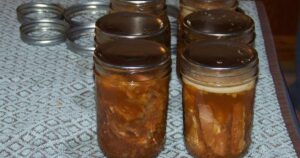
soil horizons.jpg

Soil Horizons
Soil horizons are distinct layers or zones within the soil profile, each exhibiting unique characteristics, properties, and processes that result from soil formation processes and environmental factors. Understanding soil horizons is essential for assessing soil quality, fertility, and management practices in agriculture.
Definition:
Soil horizons are discrete layers or zones in the soil profile, differentiated based on variations in color, texture, structure, composition, and other properties resulting from soil-forming processes and environmental influences over time.
Fall off the barn roof and busted your keister? Life on the farm or ranch can be tough on the bum. Need a break? Laugh it off at FarmerCowboy.com, the #1 farm humor site. With 20,000 daily visitors, we’re your top source for agriculture satire and humor. Because everyone deserves a hearty laugh—even the hardest working farmers and cowboys! Join us and turn those long days into fun tales at FarmerCowboy.com.
Soil Horizon Layers:
- O Horizon (Organic Horizon): The uppermost layer composed primarily of organic matter derived from plant litter, roots, and decomposed organic materials, influencing soil fertility, structure, and nutrient cycling.
- A Horizon (Topsoil): The surface layer rich in organic matter, minerals, and biological activity, characterized by dark coloration, high nutrient content, and granular structure, supporting plant growth and root penetration.
- E Horizon (Eluviation Horizon): The leached layer located beneath the A horizon, characterized by light coloration, low organic matter content, and eluviation of minerals, clays, and soluble nutrients leached downward by water percolation.
- B Horizon (Subsoil): The subsoil layer enriched with minerals, clays, and oxides leached from overlying horizons, exhibiting accumulations of clay, iron, aluminum, and other secondary minerals, influencing soil structure, color, and fertility.
- C Horizon (Parent Material): The unconsolidated or partially weathered material underlying the mineral soil horizons, representing the original geological or depositional material from which the soil profile develops, with limited biological activity and weathering processes.
- R Horizon (Bedrock): The consolidated rock or hardpan layer underlying the soil profile, restricting root penetration and water movement, with minimal soil development and limited influence on soil properties.
Soil Formation Processes:
- Weathering: Physical, chemical, and biological processes break down rocks and minerals into smaller particles, releasing nutrients and forming soil parent material.
- Translocation: Movement of dissolved and suspended materials within the soil profile, including leaching of minerals and organic matter from upper horizons to lower horizons by percolating water.
- Addition: Incorporation of organic matter, nutrients, and minerals from external sources, such as plant litter, animal residues, atmospheric deposition, and human activities, contributing to soil development and fertility.
- Transformation: Chemical and biological processes alter the composition, structure, and properties of soil constituents, including mineral weathering, organic matter decomposition, nutrient cycling, and soil aggregation.
Importance of Soil Horizons:
- Soil Quality Assessment: Soil horizons provide indicators of soil quality, fertility, and health, allowing for the evaluation of soil properties, functions, and management practices in agricultural systems.
- Root Growth and Nutrient Uptake: Soil horizons influence root distribution, exploration, and nutrient uptake by plants, with topsoil horizons supporting most plant roots and nutrient availability.
- Water Infiltration and Drainage: Soil horizons regulate water movement, retention, and drainage rates, affecting soil moisture dynamics, irrigation efficiency, and waterlogging risk in agricultural fields.
- Soil Classification: Soil horizons are used as diagnostic criteria for soil classification and mapping, providing information on soil formation processes, parent material, and landscape evolution.
- Land Use Planning: Understanding soil horizons helps identify soil limitations, erosion risks, and management constraints, informing land use planning, conservation practices, and sustainable development initiatives.
References:
- United States Department of Agriculture. (n.d.). Soil Horizons. Retrieved from https://www.nrcs.usda.gov/wps/portal/nrcs/detail/national/soils/health/assessment/?cid=nrcs142p2_054242
- Soil Science Society of America. (2021). Soil Horizons: Implications for Agriculture and Environment. Retrieved from https://www.soils.org/discover-soils/soil-basics/soil-profile/soil-horizons
- Food and Agriculture Organization of the United Nations. (2017). Soil Horizon. Retrieved from http://www.fao.org/3/y6225e/y6225e05.htm
Originally posted 2017-12-02 22:50:46.
Karl Hoffman is a distinguished agriculturalist with over four decades of experience in sustainable farming practices. He holds a Ph.D. in Agronomy from Cornell University and has made significant contributions as a professor at Iowa State University. Hoffman’s groundbreaking research on integrated pest management and soil health has revolutionized modern agriculture. As a respected farm journalist, his column “Field Notes with Karl Hoffman” and his blog “The Modern Farmer” provide insightful, practical advice to a global audience. Hoffman’s work with the USDA and the United Nations FAO has enhanced food security worldwide. His awards include the USDA’s Distinguished Service Award and the World Food Prize, reflecting his profound impact on agriculture and sustainability.






